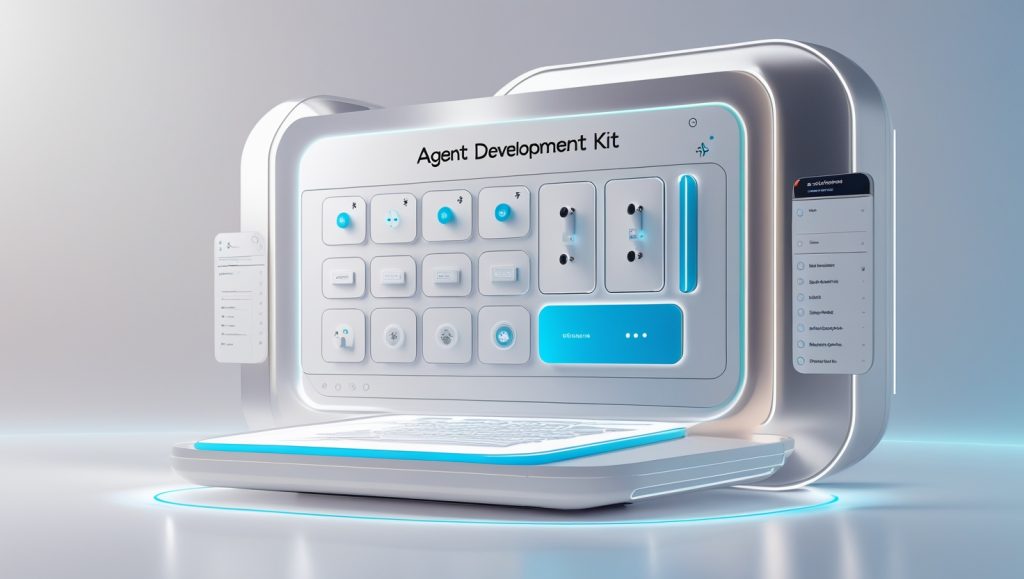This blog will help you build your first AI agent using Google’s Agent Development Kit (ADK). It is a Python-based open-source framework meant for developing, testing, and deploying AI agents. This framework enables you to pay attention to the development of your code and stay away from configurations, making it a good fit for all levels of programming skills.
What is Agent Development Kit (ADK)?
The Agent Development Kit (ADK) is Google’s open-source framework created to build intelligent AI agents. It contains characteristics that make it stand out from other
available frameworks:
Code-First Flexibility: ADK was aimed at the writing but not the configuration of the code, so the developers will have more freedom.
Modular Architecture: It offers not only built-in tools such as Google Search but also allows you to make and implement specific tools for your needs.
Model Agnostic: Through the assistance of several AI models, among them being Google Gemini, ADK is allowing the user to combine not only Gemini but also other powerful models.
Deployment Agnostic: The developed agents are flexible in terms of hosting facilities, hence, they can be placed in AWS, Azure, or inside your personal infrastructure, and they can be deployed from any location.
Interoperability: ADK integrates with other widely known frameworks, including LangChain and CrewAI.
Debugging UI: You have access to a powerful debugging interface that runs in a browser, enabling you to view and analyse agent output throughout the execution process.
Fundamental Aspects of ADK
Recalling the features of ADK will greatly help you while building your agent. These are the essential concepts which you are going to work with:
1. Agent
An Agent is the being that carries out activities according to your instructions. You may create agents for particular duties such as gathering data, executing operations, or communicating with other interfaces.
2. Types of Agents
You can find different types of agents in ADK according to your requirements:
LLM Agent: Uses a large language model (LLM) for carrying out particular works needing text comprehension and generation.
Workflow Agent: Completes tasks by performing a set of steps in a defined order.
3. Tools
Tools allow agents to perform specific actions like searching the web, making API calls, or executing scripts. You can use ADK’s built-in tools or create your own to fit unique requirements.
4. Callbacks
Callbacks enable agents to trigger specific actions after completing a task. For example, you might want the agent to send a confirmation message or take additional steps after finishing a task.
5. Session & State
ADK agents can maintain context over time by storing the session state. This allows the agent to remember previous interactions, making it more efficient and natural during conversations.
6. Memory
Memory allows agents to recall past interactions, providing a more personalised experience. For example, an agent can remember user preferences or information provided in previous conversations, which helps to create a more coherent long-term interaction.
7. Code Execution
ADK agents can autonomously run code when necessary. This feature is useful for tasks that require custom logic, data processing, or advanced operations that go beyond simple tool usage.
8. Task Planning
With task planning, ADK agents can break down larger tasks into smaller, manageable steps. This makes it easier to handle complex workflows and ensures that tasks are completed in an organised manner.
9. Runner
The Runner is the component responsible for managing the agent’s execution flow. It ensures that tasks are executed in the correct order and that the agent is performing as expected.
10. Protocols
ADK supports two main protocols for communication:
- MCP (Model Context Protocol) for communication between the agent and tools.
- ATU (Agent-Agent) for communication between multiple agents.
Building Your First AI Agent: A News Agent Example

Project Overview
In this tutorial, you’ll learn how to build a simple News Agent. The agent will:
- Use Google Search to find the latest news articles.
- Integrate memory to store user preferences.
- Output results via a web-based user interface for easy interaction and debugging.
This basic example will help you understand how to set up a functional agent. As you become more comfortable with ADK, you’ll be able to build more sophisticated agents with additional capabilities.
Getting Started
To begin building your agent, follow these steps:
Step 1: Set Up Your Development Environment
You’ll need a development environment where you can write and test your agent. A code editor like Visual Studio Code will work well. Additionally, you’ll need to set up a virtual environment to keep your project dependencies organised.
Step 2: Set Up Your Project
Create a new folder for your project, and inside it, set up the required files:
- A file for the agent’s instructions.
- A separate file for utility functions that will help with data processing and other tasks.
- An environment file to store sensitive information, like API keys.
Step 3: Obtain API Keys
To use Google Search, you will need to obtain an API key. This key will allow your agent to access Google’s search functionality and fetch the latest news articles.
Step 4: Design the Agent’s Workflow
Now it’s time to create the logic for your agent. The workflow for the News Agent will include:
- Search: The agent will use the Google Search tool to fetch the latest news based on a user’s query.
- Memory: The agent will store user preferences, such as news topics they are interested in, so it can customise the news feed in future interactions.
- Response: The agent will process the news articles and return the most relevant results to the user.
Step 5: Test and Debug Your Agent
ADK provides a debugging UI that makes it easy to monitor the agent’s performance. You can inspect its memory, review the steps it takes, and see how it interacts with various tools. This feature is incredibly useful for fine-tuning and ensuring that your agent behaves as expected.
Conclusion
Congratulations! You’ve just built your first AI agent using Google’s Agent Development Kit (ADK). While this example was simple, it’s a foundation that you can build upon. As you gain more experience, you can create even more sophisticated agents with advanced features like multi-agent communication, third-party integrations, and complex workflows.
Stay tuned for future tutorials where we’ll explore more advanced topics in AI agent development, and keep experimenting with the tools and techniques available in ADK!
Call to Action
Did you find this tutorial helpful? Subscribe to our blog for more AI agent-building guides and tips. Feel free to share your thoughts or ask questions in the comments section!
GALTech School of Technology provides hands-on training in AI agents, web development, Digital Marketing and Data Science. Join our courses to build real-world skills and kickstart your career in tech.
call:+91 70127 16483







